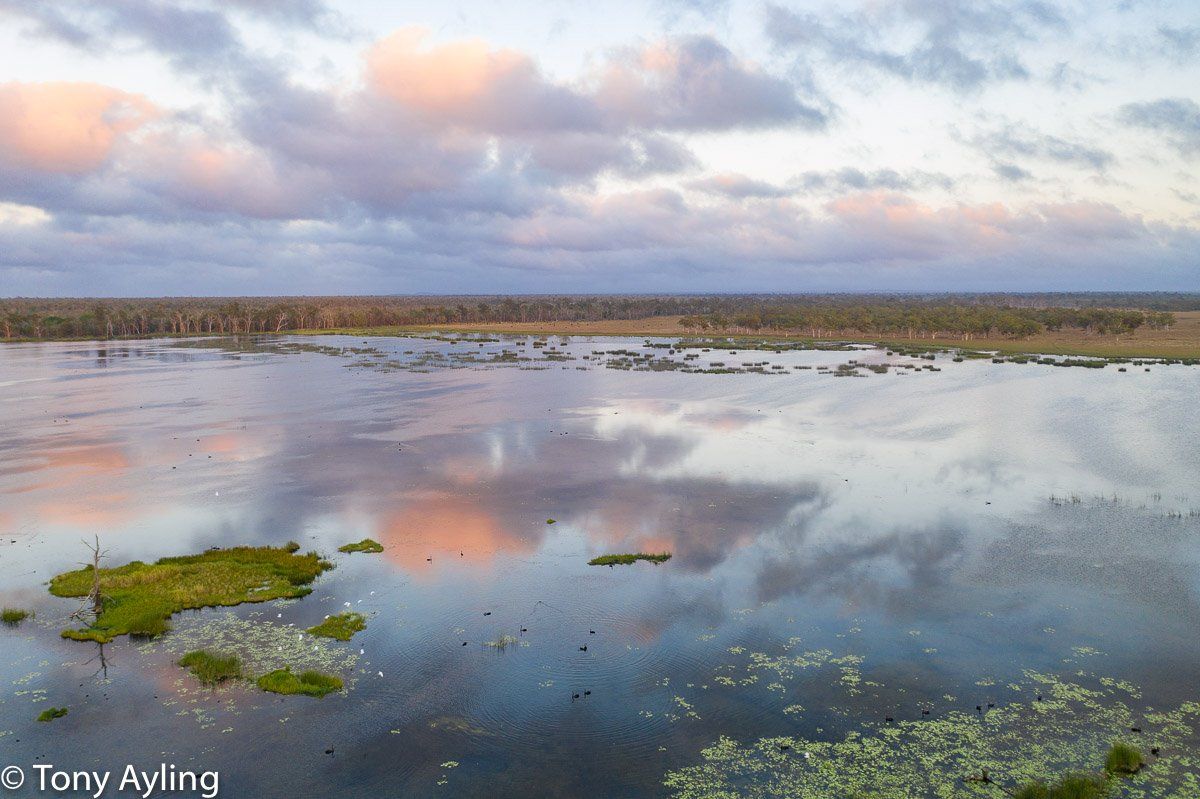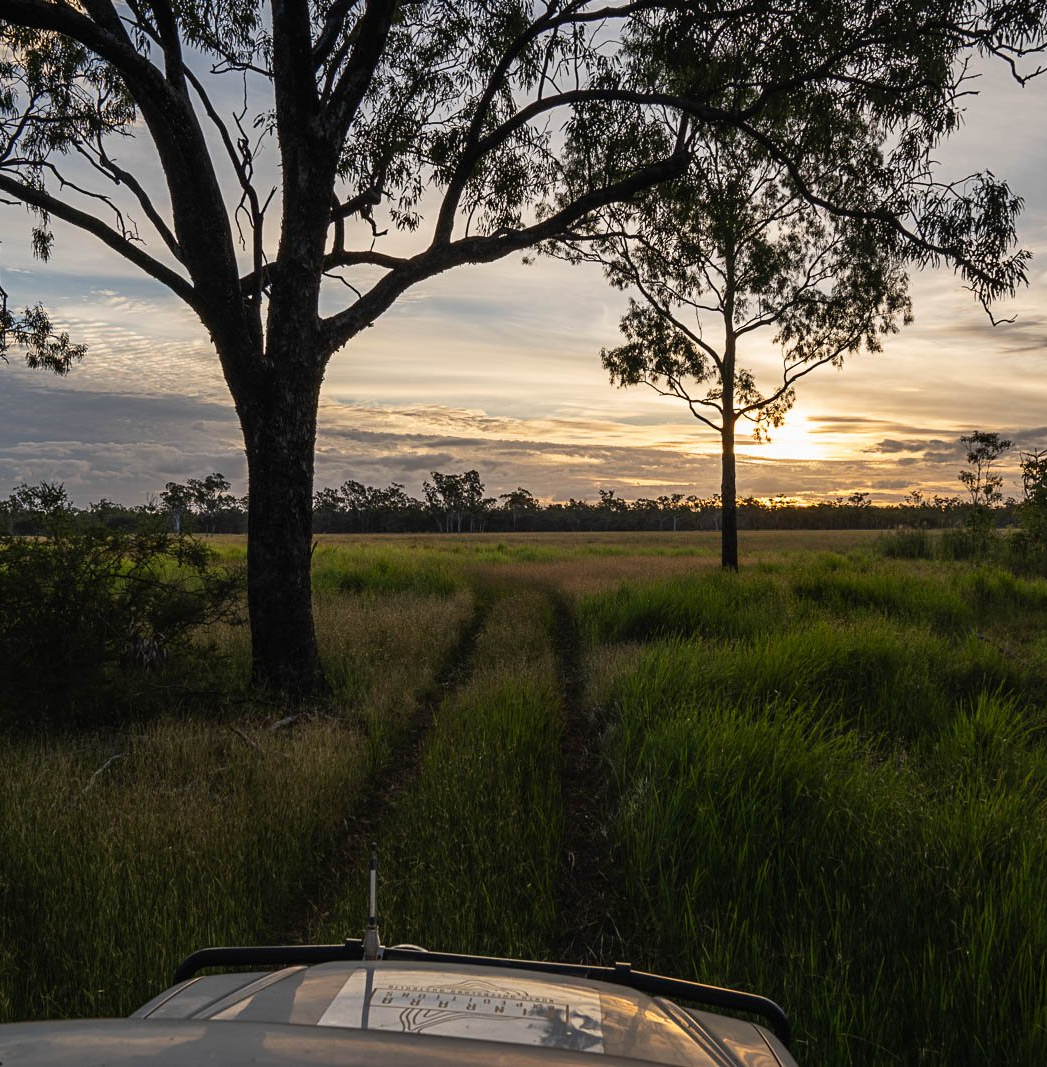A stunning oasis in an unexpected landscape
The story from the beginning
Excerpt from the Preface from Gugu Budhun - People of the Valley of Lagoons...
...The Gugu Badhun creation story of Numunali the bronzed-winged pigeon and Bunbunba the pheasant, that has been handed down from one generation to the next in our oral history, marks a 20,000-year-old geological event. The story explains how the lava flow from the Kinrara Volcano created the Gugu Badhun landscape. It is an important creation story which explains how the Gugu Badhun universe was formed. It is our cosmology. The ancient lava flow caused the creation of the mountains, valleys, and permanent spring-fed creeks that are the beginning and the source of the Burdekin River — the life giver to the Gugu Badhun plants and animals. The upper Burdekin — or the black Burdekin — River gave sustenance and life to country and our people for millennia. The same ecology and natural resources that supported and maintained Gugu Badhun people for thousands of years were also attractive to the colonisers. The permanent spring-fed creeks, lagoons and open grassy woodlands of the area were regarded as prime grazing country and, in the late 1800s, the pastoralists moved in......
...Along the watercourses, the vegetation is thick and green, but away from the water it changes dramatically. Here, the countryside is predominantly open eucalypt woodland, dominated by ironbarks and with an understory of grass. While not arid country, it is certainly not lush. Grey kangaroos and agile wallabies are the most obvious mammals, but possums, echidna, bandicoots and many others live here too. Large birds include emu and bustards, while apostle-birds, honeyeaters and parrots provide a noisy background to this archetypal Australian bush setting. In places where the basalt is on the surface, the land may appear barren, but beneath the surface the fissured rock provides the source of the life-giving springs of water that nourish these lands.
The story of Kinrara's land today
Following in the footsteps of his Grandfather and Father, Shane O’Brien is a respected modern day grazier in the North Queensland area. Born just next door to Kinrara, the original location of the family's settlement in the region in the early 1960’s, Craigs Pocket.
The eldest of 4 brothers Shane has worked with the family business his entire life, continuing this tradition Shane, his wife Robyn and sons Angus, Stirling and Corbett now own and run Kinrara Station, a fully operational cattle, eco-tourism and carbon sequestration enterprise. The family manages multiple large herds of cattle spread across the region. Shane and Robyn are stewards of the Kinrara Nature reserve, which hosts MacEachern's Camp, the landmark property for Kinrara Expeditions.
With dramatic open expanse, the ever changing landscape offers an immersive environment, cattle roam free in large paddocks feeding on grasses shaded by ironbark gum trees, Australian native animals are visible everywhere one looks, and everyday life ‘in the real world’ couldn’t be further from your mind.
Kinrara station surrounds Kinrara National Park, a private park with no public access. The vine thicket rainforest (1 of only 2 remaining) and solidified lava flow around the camp site are engulfed in what seems endless artesian water. This source flows out of the ground literally 10’s of meters from the Kinrara station homestead.
The land is almost entirely ‘incongruous’ as Jo Mckay explained in our Qantas Travel Insider Magazine from January of 2019,
...we pull up at a patch of bleached grass on the opposite side of the field. As we pile out of the 4WDs, laughter ripples through the group; it’s a mix of awe and disbelief. Behind us are hectares of grass dotted with livestock and gum trees in a palette of parchment, cinnamon and sage-green, while in front is a miniature rainforest with an emerald canopy of umbrella palms and fig trees. At its centre, a clear spring gushes from an unseen source into a shallow three-tiered waterfall between banks stacked with lush ferns. Cattle. Outback. Rainforest. Waterfalls. The combination seems incongruous and remarkable.
Facts and figures about Kinrara
Where is Kinrara?
250km south west of Cairns, 120km east of Cardwell, Queensland, Australia.
How do you get to Kinrara?
4WD convoy with Kinrara Expeditions, departing on a Monday morning at 9:00am from the Cairns CBD, returning back to Cairns by 5:00 pm Friday.
How much land does Kinrara cover?
Including the Kinrara National Park approximately 70,000 acres.
Is there an active volcano at Kinrara?
Yes (kind of), the Kinrara volcano is the last volcanic eruption on the continent of Australia. This is estimated to have occurred between 7,000-9,000 years ago leaving behind an intact volcano with crater, and a 30km long solidified lava flow that can still be clearly seen from space. A dormant or extinct volcano is considered to be 10,000 years old or more. Given this, Kinrara represents the youngest landscape in Australia, it’s like stepping back in time to see how Australia was formed.
Was there only one eruption?
No, the science suggests there was upward of 7 major eruptions and lava flow experiences.
How many bird species have been identified at Kinrara?
Our current log suggests that of the possible 220 bird species in the area 195 have been identified at Kinrara, with the vast majority spotted directly out front of the campsite.
How many cattle are on Kinrara?
Depending on the weather and time of year, Kinrara can run between 4,000 and 10,000 cattle.
The story from the beginning
Excerpt from the Preface from Gugu Budhun - People of the Valley of Lagoons...
...The Gugu Badhun creation story of Numunali the bronzed-winged pigeon and Bunbunba the pheasant, that has been handed down from one generation to the next in our oral history, marks a 20,000-year-old geological event. The story explains how the lava flow from the Kinrara Volcano created the Gugu Badhun landscape. It is an important creation story which explains how the Gugu Badhun universe was formed. It is our cosmology. The ancient lava flow caused the creation of the mountains, valleys, and permanent spring-fed creeks that are the beginning and the source of the Burdekin River — the life giver to the Gugu Badhun plants and animals. The upper Burdekin — or the black Burdekin — River gave sustenance and life to country and our people for millennia. The same ecology and natural resources that supported and maintained Gugu Badhun people for thousands of years were also attractive to the colonisers. The permanent spring-fed creeks, lagoons and open grassy woodlands of the area were regarded as prime grazing country and, in the late 1800s, the pastoralists moved in......
...Along the watercourses, the vegetation is thick and green, but away from the water it changes dramatically. Here, the countryside is predominantly open eucalypt woodland, dominated by ironbarks and with an understory of grass. While not arid country, it is certainly not lush. Grey kangaroos and agile wallabies are the most obvious mammals, but possums, echidna, bandicoots and many others live here too. Large birds include emu and bustards, while apostle-birds, honeyeaters and parrots provide a noisy background to this archetypal Australian bush setting. In places where the basalt is on the surface, the land may appear barren, but beneath the surface the fissured rock provides the source of the life-giving springs of water that nourish these lands.
The story of Kinrara's land today
Following in the footsteps of his Grandfather and Father, Shane O’Brien is a respected modern day grazier in the North Queensland area. Born just next door to Kinrara, the original location of the family's settlement in the region in the early 1960’s, Craigs Pocket.
The eldest of 4 brothers Shane has worked with the family business his entire life, continuing this tradition Shane, his wife Robyn and sons Angus, Stirling and Corbett now own and run Kinrara Station, a fully operational cattle, eco-tourism and carbon sequestration enterprise. The family manages multiple large herds of cattle spread across the region. Shane and Robyn are stewards of the Kinrara Nature reserve, which hosts MacEachern's Camp, the landmark property for Kinrara Expeditions.
With dramatic open expanse, the ever changing landscape offers an immersive environment, cattle roam free in large paddocks feeding on grasses shaded by ironbark gum trees, Australian native animals are visible everywhere one looks, and everyday life ‘in the real world’ couldn’t be further from your mind.
Kinrara station surrounds Kinrara National Park, a private park with no public access. The vine thicket rainforest (1 of only 2 remaining) and solidified lava flow around the camp site are engulfed in what seems endless artesian water. This source flows out of the ground literally 10’s of meters from the Kinrara station homestead.
The land is almost entirely ‘incongruous’ as Jo Mckay explained in our Qantas Travel Insider Magazine from January of 2019,
...we pull up at a patch of bleached grass on the opposite side of the field. As we pile out of the 4WDs, laughter ripples through the group; it’s a mix of awe and disbelief. Behind us are hectares of grass dotted with livestock and gum trees in a palette of parchment, cinnamon and sage-green, while in front is a miniature rainforest with an emerald canopy of umbrella palms and fig trees. At its centre, a clear spring gushes from an unseen source into
a shallow three-tiered waterfall between banks stacked with lush ferns. Cattle. Outback. Rainforest. Waterfalls.
The combination seems incongruous and remarkable.
Facts and figures about Kinrara
Where is Kinrara?
250km south west of Cairns, 120km east of Cardwell, Queensland, Australia.
How do you get to Kinrara?
4WD convoy with Kinrara Expeditions, departing on a Monday morning at 9:30 from the Cairns CBD, returning back to Cairns between 2-3 pm Friday.
How much land does Kinrara cover?
Including the Kinrara National Park approximately 70,000 acres.
Is there an active volcano at Kinrara?
Yes (kind of), the Kinrara volcano is the last volcanic eruption on the continent of Australia. This is estimated to have occurred between 7,000-9,000 years ago leaving behind an intact volcano with crater, and a 30km long solidified lava flow that can still be clearly seen from space. A dormant or extinct volcano is considered to be 10,000 years old or more. Given this, Kinrara represents the youngest landscape in Australia, it’s like stepping back in time to see how Australia was formed.
Was there only one eruption?
No, the science suggests there was upward of 7 major eruptions and lava flow experiences.
How many bird species have been identified at Kinrara?
Our current log suggests that of the possible 220 bird species in the area 195 have been identified at Kinrara, with the vast majority spotted directly out front of the campsite.
How many cattle are on Kinrara?
Depending on the weather and time of year, Kinrara can run between 4,000 and 10,000 cattle.











